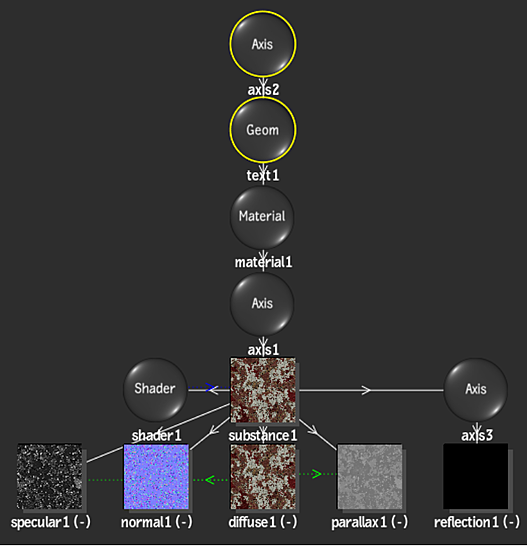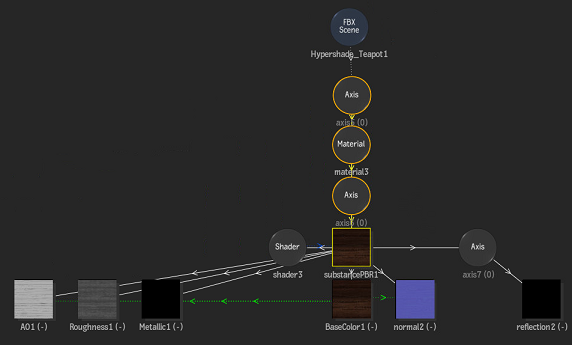Navigating the Schematic with a Substance Texture
When you load a Substance Texture preset into the Action schematic, multiple nodes are added and connected with different types of links, creating a type of Substance group. You can work with the menus of the various nodes (such as the Parallax node) as you would if you had added the object manually.

Keep in mind the following when working with Substance Texture presets in the schematic and menus:
The Substance node is parented by an Axis node, itself parented by a Material node, and is the parent of some or all of the following map nodes:
- Specular node — see Specular Mapping
- Normal node — see Normal Mapping
- Diffuse node — see Diffuse Mapping
- Parallax node — see Parallax Mapping
- Displacement node (locked to Hardware Displacement) — see Displacement Mapping
- Emissive node — see Emissive Mapping
Media is automatically applied to these mapping nodes, and cannot be changed.
The Substance node is also parented to a Reflection node, with its own axis. You can apply media to the Reflection node. See Reflection Mapping.
A Shader node is parented from the Substance node. Lighting links (blue dotted lines) are applied from the Shader node to the Substance node and the originally selected surface or geometry. Shader node settings override Material node settings (at the exception of Transparency and Ambient settings). See Using the Shader Node.
Some presets require you to add input media to feed into the Substance node and attached maps to create a plausible effect. For example, the Broken_Glass preset in the Glass category requires one input node. See Substance Textures with Inputs.
All Map parameters are loaded with default values based on the loaded Preset. The Repeat Mode is automatically set to Tile Repeat on all attached maps. Reflection map parameters sometimes have an expression automatically set on its effect or softness values.
The Diffuse node acts as an originating duplicate object to the present Specular, Normal, Emissive, and Parallax nodes (green dotted lines). Therefore, any common settings applied to one of these map nodes are applied to all map nodes. The common settings are found in the Texture tab of any of the map menus. See Mimicking, Copying, and Duplicating Objects.
Since the Substance preset requires all of the loaded objects, and the parenting, lighting, and duplicate links to function correctly, you are unable to delete any of the objects separately, or break any of the links.
Some presets load and use only the maps that are needed for that preset. For example, the Defocused_Light preset in the Abstract category includes only an Emissive map that blends in additive mode with the diffuse colour of the attached surface or geometry. In this case, the preset works best if the diffuse colour in the Geometry or Image menu is set to black.
You cannot parent an object from any of the Substance objects. You can parent the Material node to another object to substitute for one of the Substance maps. For example, you can add a Diffuse map and connect it to the Material node, and then hide the Substance Diffuse map so that it is no longer applied to the Substance effect.
If you select a surface or geometry before adding the Substance Texture preset, the connection to the Material node of the Substance node, and the lighting link from the Shader node are automatically applied. If you do not select a surface or geometry first, you have to make these connections manually for the Substance node to function correctly.
Substance PBR Schematics
A Substance PBR schematic is similar to a Substance Texture schematic. It consists of a Material node, a Shader node, a Substance node containing all the relevant preset controls, and the corresponding texture maps generated by the Substance engine. Some of these texture maps correspond to PBS Map nodes (in this example the BaseColor, Metallic, Roughness, and AO nodes are PBS Maps):

- The Shader node defines the shading of the PBS texture maps generated by the Substance engine.
- In a PBS workflow, some Physically Based shader settings or PBS map settings override the Material node settings. In this case, specular and shine settings in the Material menu do not have any effect. If transparency is not needed, the Material node is not required, and can be removed.
